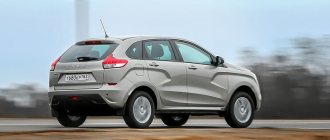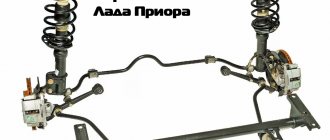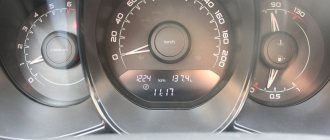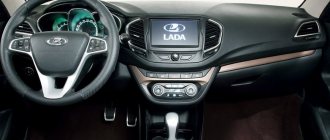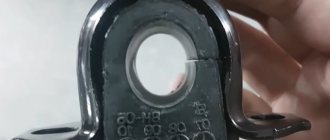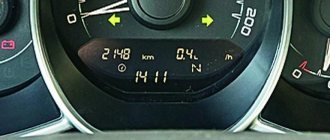Journalists from the publication RG.ru were among the first to get acquainted with the new Russian sedan Lada Vesta 2021. During the winter test, portal columnist Yuri Zubko took a ride in a car with a 1.6-liter engine producing 106 hp. and the AMT robot.
Wipers are another point on which you can and should find fault. We tested the car in difficult weather conditions - Moscow and the Moscow region were covered with snow, so we tested the operation of the windshield wipers a lot. First the right wiper failed, then the left one, the driver's one. All the time I had to stop and bring them back to life.
There is plenty of space for both the driver and passengers. People with a height of 180 centimeters can easily accommodate people in the back row. Which, for example, is problematic to do in the same Volkswagen Polo.
The steering wheel is very responsive - the car clearly goes where you want it to go. But the operation of an automated manual transmission (AMT) may not appeal to everyone. In not the best climatic conditions, the AMT often does not have enough strength to switch in time. Therefore, it is easier to switch to mechanics that work more harmoniously.
Denis Halfin from the AvtoVzglyad publication tested the Lada Vesta 1.6 (106 hp) MT sedan. The journalist assessed the car's interior, noting its pros and cons.
Hidden even lower are a pair of cup holders, a 12V socket, a USB connector, and at the base there is a small area for small items - there is somewhere to put your phone and a glass of coffee will fit. But as for the dashboard, the digitization personally seemed small and indistinct to me, although the overall design looks impressive.
Vesta will provide a hospitable welcome to drivers with the most unusual build. Adjusting the steering column for tilt and reach came in very handy, and the range of seat settings was enough for the eyes. Although the chair itself cannot be called a throne - the cushion is a little short, which is why on a long journey you feel discomfort in your legs due to the additional tension.
But what the manufacturer took full care of was the lateral support of the seats, which here builds up morale. Another nice touch is the armrest on the driver’s right, which very usefully serves as a support instead of the usual box between the front seats.
There are no special problems with free space either in front or behind, unless we are talking about second-row passengers with a height of over 185 cm. In the “gallery”, tall riders will have to put up with a low ceiling. But there is plenty of legroom here.
The Lada engine has an advantage in power and torque, but in fact the 100-horsepower Solaris 1.4 accelerates a little faster - the larger Vesta, packed with equipment, is 100 kg heavier! True, starting from a standstill on a Hyundai is complicated by a light and uninformative clutch in combination with a very “sharp” gas pedal.
Driving a Hyundai on a winding road is a thrill, something that surprised him even during the first test. The chassis is tuned perfectly, and the necessary feedback is always present on the “light” steering wheel. But Vesta is no mistake! It stands no less confidently on high-speed curves, although the steering here lacks “transparency” a little.
What’s really great is that both sedans are not afraid of Russian roads - both Lada and Hyundai confidently slap their tires over holes, patches, bumps and hatches. It’s okay! Except that the Vesta shudders more with its 16-inch wheels at joints and bumps with sharp edges.
But the Lada has stopped rattling its suspension, which is what the cars worried us about during last year’s tests. And the noise from the tires does not penetrate into the Vesta’s cabin as persistently as in the Solaris - on a long trip it will be more comfortable in the Lada.
Portal Behind the Wheel tested the Lada Vesta Exclusive 1.8 MT sedan. Journalist Alexander Tychinin helped identify the advantages and disadvantages of the Russian four-door.
But I can't help but grumble about the thick stands and noticeable lack of quality. Plastic of different textures, rough stitching on the steering wheel rim, a flimsy and low driver's seat armrest, unclear efforts on the climate controls, an inconvenient multimedia system and that cheap power window unit...
Despite the light clutch pedal, the Vesta has a good feel for starting from a standstill; there is no need to apply gas. Our 1.8 is tuned well, although I heard from many colleagues that it twitches noticeably at low speeds, like a “classic” that sucks excess air into the carburetor. Apparently, quality varies from machine to machine. So on this Vesta, if you accelerate to the floor, then when switching the French “mechanics” you will notice a drop in traction.
And where, exactly, are 122 “horses”? I remember how fervently Solaris 1.6 rushes, which is only one power more powerful, but Vesta 1.8 cannot be called a “lighter”. Yes, it comes out a little faster than with a 1.6 engine with 106 hp. s., and the sound is more interesting, but not to say “heaven and earth”. Unfortunately, winter tires and wet weather did not allow for full dynamics measurements.
However, the elasticity felt better. This is good, because there is no pleasure in interacting with the gear lever: the drive is unclear and seems flimsy. Why the hell is there such a huge expense? The on-board computer shows as much as 10.5 l/100 km, and that’s a lot. Even though the test Vesta's mileage is only 1000 km, we are not the only ones complaining about the brutal appetite of the new engine.
Sedan capabilities
After a test drive of the car was carried out in the city and on the highway, it was decided to drive on a country road. And due to the almost 18 cm of ground clearance, we were able to easily drive in those places where the Rio and Solaris began to touch the ground with their bottoms. Vesta, practically without slowing down, drove along a very deep rut, while the SUV drivers in front were in bewilderment when the domestic Lada Vesta blinked its headlights behind them. Carrying out such a very extreme test drive for the sedan, we understood that there was a high probability that a tow would be needed, but the car continued to calmly cope with the assigned tasks.
Moving along the highway, the car holds well at high speeds, so before even a strong climb, you can not be afraid to accelerate and go into third gear. By the way, on the new Lada, we had to feel the traction control system only once, when we missed a necessary turn. Therefore, the pre-prepared shovel and the accompanying SUV for towing never had to be used.
When we returned to the city, all test drive participants came to a unanimous opinion about the car. It really is worth the price. By the way, we recommend that off-road enthusiasts take care in advance about installing good crankcase protection. The factory installed option does not have the required level of protection and therefore stones can damage the engine.
When to change the timing belt?
On Vesta the unit is different, 16-valve. But the components for it are from the same suppliers. And the mileage already makes you think about changing the timing belt preventively, without waiting for catastrophic consequences. If it were my personal car, I would do it that way. However, the “Behind the Wheel” life tests imply strict adherence to the maintenance regimen prescribed by the factory. And in the Vesta service book there is not a word about the mandatory replacement of the timing belt. Only reservations about condition monitoring at each maintenance. So, we’ll keep an eye on it and wait a while with the replacement. Although the experience of Granta and Datsun is annoying. Moreover, both cars did not stop at the doorstep of the editorial office, but in the Tula and Vladimir regions.
The red sedan continues to clock up the kilometers. By refusing dealer service in favor of independent service, I expect a reduction in the cost per kilometer. If there are no unscheduled malfunctions, Vesta has a chance to become the cheapest car in the Za Rulem fleet.
- You can operate any editorial vehicle in our “ZR Park” section.
- The most popular accessory for Vesta now is radiator protection. We also recommend taking a look at towbars, hood supports and car floor mats.
Lada Vesta sedan (2017-2018) - owner reviews and review
Competitors:
Volkswagen Polo sedan, Kia Rio sedan, Hyundai Solaris sedan, Skoda Rapid liftback.
Safety.
Two front airbags and a stability control system are already standard. Side airbags and fog lights are available starting with the Luxe trim level. According to the ARCAP crash test, the Lada Vesta sedan scored 14.1 points out of 16 possible, which is higher than the third generation Ford Focus and first generation Hyundai Solaris. No other safety tests were performed.
Definitely: Yes! Lada Vesta sedan is a new starting point for AvtoVAZ. The car turned out to be nice, inexpensive and competitive. Within a year of the start of sales, the Lada Vesta sedan rose to fourth place in the ranking of the best-selling cars in Russia, displacing its direct competitor Hyundai Solaris. There are constantly debates on the Internet about whether Vesta is a foreign car or a Lada. In terms of equipment and the way the doors close, it is undoubtedly a foreign car, but in terms of minor ergonomic flaws, in terms of the failure of the marketing strategy, namely the lack of a hydromechanical automatic transmission, and in terms of the response of the control buttons, it is a Lada.
Advantages and disadvantages of the Lada Vesta sedan in comparison with competitors:
- Advantages and benefits
- Has an adjustable lumbar support.
- Adjustable steering wheel for reach and tilt.
- Car price.
- CASCO and maintenance costs.
- The most spacious cabin in the class.
- Good sound insulation.
- Disadvantages and cons
- Unstable quality of cars. Each Vesta is unique in its own way.
- Low quality components.
- Miscalculations in ergonomics.
- Hard plastic in the cabin.
- Indistinct sensations on the control keys.
- Two-pedal version with robotic gearbox only.
- A crude 1.8 engine, which was marked by a drop in traction at the bottom and excessive oil consumption.
Similar models ⬇:
Test drive Lada Vesta with manual transmission
Details Category: Test drive Published 12/27/2015
Yesterday a presentation of the Lada Vesta took place in Naberezhnye Chelny. We took the first test drive of a Lada Vesta with manual transmission . More on impressions below.
Let us remind you that we recently talked about our emotions after a test drive of a Lada Vesta with a “robot” in Kazan. Yesterday we visited the Auto-1 car showroom, where a presentation of the new product took place in Naberezhnye Chelny. During the presentation, a recording was made for a test drive of a Lada Vesta with a manual transmission . Of course, we couldn’t miss the opportunity to compare the Lada Vesta with a “robot” and a manual transmission.
We had to ride this white beauty.
Compared to other test cars, Lada Vesta looks special.
A short paperwork procedure and we go for a test drive.
We have already talked in detail about the convenience and settings of the workplace while driving Vesta.
This time we got a car in the “Comfort” configuration - this is an average configuration: without a rear view camera, touch monitor and other options.
The car is equipped with a 1.6 liter VAZ engine with a power of 106 hp. It is paired with a new five-speed manual transmission, created by AVTOVAZ in partnership with the Renault-Nissan alliance.
After warming up the car a little, we set off for the trip.
What can we say about the “mechanics” on Vesta ? It is qualitatively different from everything that was previously on Lada cars. The lever strokes are not very short, but clear. The lever itself fits comfortably in the hand.
Vesta uses a cable-driven gearbox. You will say that cable-driven gearboxes have long been installed on the same Kalinas and Grants. Yes, but even compared to them, the “mechanics” on the Vesta are clearer, and the gear shifts are smoother.
But the most pleasant difference between the “mechanics” on the Lada Vesta is the sound. Or rather, its absence. Anyone who has driven a Lada car at least a little probably cannot forget these transmission sounds - hum and howl, especially in 2nd gear.
Subconsciously, we expected the same from Vesta. Fortunately, we were wrong. Even when switching from 3rd to 2nd gear with a shift, the box does not make any sounds when releasing the clutch. And the engine noise does not bother the driver and passengers. All this completely erases from your mind the idea that you are driving a domestic car.
By the way, the clutch drive here is also different from the traditional one on VAZ front-wheel drive cars. There is no longer a cable drive, but a hydraulic clutch drive. The pedal has a fairly long stroke and allows you to handle it quite casually - the car still moves off smoothly and without jerking. Again, let's remember the owners of Kalin, Prior and Grant. Remember that annoying clicking sound when you release the clutch pedal? This is how the clutch cable tensioner mechanism installed on the clutch pedal works. Since the clutch drive on Vesta is hydraulic, there is no cable, and therefore no clicking mechanism either. Another plus for acoustic comfort in the cabin.
As we expected, the “mechanics” on Vesta allow you to dose the thrust very accurately. It realizes the potential of the 106-horsepower engine much better than the “robot”. You can drive economically, shifting at medium engine speeds, or you can easily accelerate in 2nd gear to 60-70 km/h. Even with such acceleration, the sound of the engine entering the cabin is muffled—we give Vesta a solid “five” for the sound insulation of the engine compartment.
The anti-rollback protection system also showed itself to be excellent - when you engage a gear and release the brake pedal, the car is held motionless for another 2 seconds, which allows even inexperienced drivers to set off without rolling back.
Let's summarize. As we thought, the manual Lada Vesta more than the robotic one. It is both cheaper than the “robotic” version and more pleasant to operate.
Lada Vesta Cross 2021 - configurations, prices and photos
Russian car enthusiasts will soon receive the 2021 Lada Vesta Cross off-road station wagon, which is perfect for local roads. It is characterized by increased ground clearance, a plastic body kit, and a number of elements that are used in interior decoration. As for the technical features of this car, they have also been improved. In addition, the new product comes with a number of useful technological options. This car organically combines a sedan with the body kit of an SUV, and as an addition, large wheels are provided. It can be noted that the car is quite attractive in exterior design.
Exterior
If we consider the 2021 Lada Vesta Cross car, the new model of which is presented to Russian consumers, and its photo and price can be seen on our resource, then the exterior of the new product turned out to be quite attractive. The original side stampings on the doors give it a sporty look. The headlights go well with the radiator grille, as well as the bumper located in the front.
At the rear of the vehicle, the headlights also fit well with the bumper and tailgate. All these elements of the car’s appearance match well with each other and in color scheme.
I went for a test drive of Lada Vesta
So, I took the Lada Vesta for a test drive and I hasten to share my impressions. Only a lazy blogger/journalist/and just a car enthusiast has not written, shown, told or joked about Vesta lately. I’ll throw my 3 rubles 40 kopecks into this topic. So, early in the morning, on a day off, I’m at the dealer’s door. I’m waiting for 9-00 in the morning and the managers, joyfully taking up their work, sign me up for a test drive of the little white Lada Vesta . Before this long-awaited moment arrived, I must admit, I managed to climb all over Vesta, one on the street, and a couple in the showroom. The first impression is another Kia Rio - Solaris - Focus and others from that company. Well, that’s good, it means VAZ did everything right. My brief report will not contain technical characteristics, there are plenty of them on the Internet, as well as statements of dry little things. I will turn off my brain as much as I can and make my subjective verdict.
I won’t freeze for a long time and will speak out right away. The car is fire. If I decide to change the rear or all-wheel drive, and want to find a front-wheel drive, Vesta is the one. Even if suddenly, somewhere in its depths, pelvic shoals pop up - to hell with them, I’ll forgive everything. She's cool, that's for sure. But only as a city asshole, from work to work, children to school, weekends - dacha. Something like that. This is not a car for traveling - it’s a bit small in size, this is not a car to “kick someone’s ass”, for this it needs to be mercilessly tuned like an adult. This is a smooth city car, with a cool design, which will give real patriots the opportunity not to feed a Hyundai Kia, but to support a VAZ.
About the pricing policy - sadness and melancholy. There seems to be no Vesta for 514 thousand in nature. Average equipment is closer to 600 thousand, I scanned the full price list at the end of the article. Please note that prices are net and for the start of sales. Draw a conclusion.
I will devote a whole paragraph to the robotic transmission, although it can be done in one word. The Lada Vesta robot is sad G. Why they put this rubbish in a good car, I can’t say. However, it is known that robots have a lot of advantages: they are unreliable, expensive compared to mechanics, and slow if installed in a mass-market car. Vesta's robot is no exception. During the test drive, the manager praised the box for its manual mode. It's cool and comfortable, yes. But there is nothing from him at all. The secret is simple: in manual or automatic D-mode, the box changes gears in as much as 2 seconds! Karl, wake up, we've been robbed!! 2 seconds, Karl.. I’m done, the drool of rage is dripping onto the laptop keyboard, I’ll feel sorry for my equipment, and forget about the dull Vesta robot. Stay away from him, my personal opinion.
Let's move on to the appearance. The tinsmith's thunderstorm, the new X-shaped, or ugly stamping. In fact, of course, it complicates the element, but I would not say that no one would ever be able to straighten it. For me, they made it too deep, I don’t know, subjectively, I would rather refuse it, given the opportunity to choose.
On the one hand, the design is cool, but I have the feeling that this is a designer “bookmark”. This is when they make it so that at first you really like the car, but after a couple of years, the model becomes familiar and begins to irritate you. Looks like this X is from this series. I don’t know, I’m talking about markers. Not a nine after all, a car with ambitions and a pronounced zest. There is something to gossip about, viral marketing, etc. Okay, empty X is emblazoned on the sides, he’ll fall in love with it.
I liked the salon, no offense to Tagaz’s accent - well, there’s no comparison. What can I say, Solaris, in my opinion, is nauseating compared to Vesta’s interior, at least I often ride a Solaris with a friend as a passenger. I don't like the design of the dashboard, the beard and the front end in general. And the new fret has an interesting one. The X on the multimedia system also infuriates. I’ll also say that Sony had a line of x-plod radio tape recorders, this reminds me of them. For the interior in its class 5 minus. No delight, just good.
In conclusion, I would like to note that a cool car has appeared among the most popular and competitive segment. I sincerely wish Vesta to break the market for Riosolaris and throw them out of the top sales list. Let it be everywhere and become familiar, but it’s ours, and it will bring us income in the form of taxes and jobs. Honestly, I’m glad, I think Vesta was a success.
Interior
The interior space of the new Russian-made product can please true connoisseurs of domestic cars. The chairs are very comfortable, and they have a large number of different adjustments that are designed to ensure a comfortable stay for people. In addition, there are a number of useful elements:
- steering column reach adjustment;
- convenient buttons and levers for controlling vehicle functions;
- the visibility of the situation is quite normal, but it is slightly obscured by the pillar located on the driver’s side;
- mirrors are large and comfortable;
- there is a lot of free space in the cabin;
- quite roomy trunk, allowing you to transport a lot of different cargo;
- original interior lighting, which is bright enough and does not have a harmful effect on vision;
- The seats are heated quite quickly.
This is interesting: Volkswagen Polo test drive video
The interior has its own highlight: bright orange inserts that make the interior space more attractive and original. If a potential buyer is a fan of muted colors, then he can choose the option with gray inserts.
For an additional fee, you can purchase a multimedia package, which includes the following elements:
- multimedia system equipped with a seven-inch touchscreen display;
- navigation system;
- six functional speakers providing high-quality music sound in the cabin;
- a high-resolution camera providing visibility into the rear of the vehicle;
- wheel (steering) with many different functions;
- Cruise control.
Technical features
Buyers will be able to get several trim levels of this car, which is equipped with a 1.6 or 1.8 liter gasoline engine. The power of the first engine option is 106 hp, and the second - 122 hp. Together with the engine, this car is equipped with a gearbox (manual) or automatic (robotic). Despite the presence of off-road attributes, the car's drive is exclusively front-wheel drive.
Experts note that the main problem of this car is that it is not equipped with a modern automatic transmission that would have a smooth and understandable operating algorithm. It is clear that in the near future in 2018 the Lada Vesta Cross sedan will not have a functional automatic transmission, but it may be installed in a few years.
The car has excellent handling, which is due to a very precise steering wheel, well placed in the zero zone, and returning to its original position after the turn operation. In urban conditions, the steering wheel is not stiff, but when driving on the highway it becomes a little heavier.
The suspension of the new product is designed quite successfully, which allows it to overcome uneven road surfaces without any problems. As for the chassis, it is quite noisy. Although, if we compare with previous generations of this car, then certain improvements are observed.
Be careful with the selector!
On the highway, the car's directional stability is not high, and the steering wheel is "indistinct". It seems that he is slightly unable to keep up with the wheels: they have already swerved to the side, and the steering wheel deviates a little later. Gusts of strong wind add to the severity of the situation; sometimes the car simply moves in a sinusoid, albeit within its lane. I look closely at my colleagues in the movement: few, apparently, experience the same problems.
The advertising brochure promises that Vesta will isolate riders from excess noise outside. How to say... Sometimes I hear a strange periodic rustling noise from under the wheels, as if the tires find themselves on sections of asphalt of varying roughness. I am gradually realizing that the sound occurs when the tires touch the markings. Since they are clearly audible, we can conclude that the sound insulation of the interior of the VAZ new product is not so good.
What about your own sounds? Their car also produces a lot. The hum of the windshield washer motor readily penetrates into the cabin. The engine's operation becomes audible to the driver already at approximately 3000 rpm. The box is also not silent - it howls slightly. And how many “crickets” are there behind the interior trim panels! Their main colonies live behind the dashboard and inside the driver's door. They are awakened to life not only by road irregularities, but also by loud music.
But that would be okay. If I owned Vesta, I would not be lazy, dismantle the doors and destroy at least some of the “insects”, gluing in places additional noise and vibration insulating linings. But what to do with the annoying signal that starts beeping when you reach 120 km/h? Let's not pretend to be righteous and claim that we only drive within the official speed limits. 120 is not a speed for modern cars, especially on open, well-cleared and highly visible highways away from populated areas. Vesta is no exception. Secretly from the observant traffic police, I accelerated the car to 150 km/h. At such a speed, the sound of the warning signal, of course, was drowned in the general noise, as well as in the sounds of music. But you can’t drive like that anywhere, ever. And we often exceed 120 km/h when overtaking. So this signal is frankly annoying on long trips.
Our test included a 1.6-liter version of Vesta with a capacity of 106 hp. With. with automatic transmission. The problems with AMT operation on the VAZ sedan are the same as on the Xray crossover. In the same way, the box seems to “sigh” before shifting up the gear. When driving slowly in traffic jams, this is not noticeable - in fact, because the movement occurs in one gear, first or second. The situation is much worse when the car is required to “shoot”, an intense jerk forward. For example, you need to fit into the flow when leaving the yard or from a secondary road to the main one. At the most crucial moment, AMT can “fail,” and this is very unpleasant.
At high highway speeds, shifts are not accompanied by “sighs” - they simply don’t have time. AMT quickly goes through all the stages and stops at the highest - the fifth. If acceleration is necessary, kick-down is triggered and one stage is reset, also without a noticeable “failure”. But take the risk of accelerating more intensely. If you reset two gears at once, there will be such a delay that it may seem as if the AMT is completely stuck. Imagine that when accelerating in a manual car, you press the clutch pedal at the peak of acceleration... Vesta demonstrates something similar.
Safety
The Russian-made car has not only passive but also active safety systems. Among the new systems are:
- stabilization system;
- effective airbags (not only for the driver, but also for the front passenger);
- assistant when driving on a hill (especially effective for drivers with little driving experience);
- other basic systems that are difficult to do without when driving in the city.
These safety systems help the car driver in difficult traffic situations to avoid serious accidents.
Cost and start of sales
If we consider the 2021 Lada Vesta Cross car (new body) in the basic configuration, then its characteristics and prices, as well as photos, can be seen on our resource. The cost of the basic version of the car is 614.9 thousand rubles. In this case, the user receives the following elements:
- power windows;
- adjustment of the steering column according to such a parameter as the departure angle;
- a computer with the necessary options;
- lock (central), which is controlled remotely.
More advanced car configurations will be offered to the user for 730 thousand rubles and more. If we consider the top-end configuration of this car, then its cost will be 807.9 thousand rubles. This vehicle configuration includes the most advanced options and systems that are installed by the manufacturer.
The car will be presented in dealer showrooms in Russia this year, so potential buyers can already choose the appropriate configuration. In addition, this car will be offered to motorists in a number of European countries.
The programs are not “numbered”
For some reason, the large LADA inscription on the trunk lid causes active rejection among motorists. It is the discharge of letters that haunts people. But to me it doesn’t seem... or at all irrelevant. In the end, I think these letters can be carefully removed. Much more interesting is the design of the lid drive. Firstly, it does not have an opening button. You can unlock it either by pressing a button in the car or on the key fob, or mechanically with a key. Secondly, if you lift it low and let it go, it will immediately lower and lock itself again. It is imperative to raise it to a vertical level, in this position it remains stable. Of course, it would be better to adjust the drive by installing the ends of the springs (you will immediately see them when you open the cover) into the “fourth” holes of the adjuster strips instead of the standard “thirds”. But this will require a lot of effort.
Here's your first minus. I’m not even talking about the fact that the semicircular hinges of the lid, when it is closed, protrude significantly into the trunk. However, which of the “state employees” can boast of a more compact mechanism? No one. So in this LADA Vesta is neither ahead nor behind.
From the hood the car is much prettier than from the back and sides. He's beautiful! The curved LED strips in the headlights attract attention. The signature rook emblem has become larger and more stylish. But again, let's open the hood. Why is the engine compartment covered in dirt during the not so long total mileage of the test car - only about 5,000 kilometers? Yes, because something was missing to install an additional hood seal, so all the dirt flies into the gap. Either they spared money, or no one has ever seen how craftsmen themselves protect engine compartments from dirt using tubular window seals. And the Vesta engine will also be insulated, while speaking about this “product” not too flatteringly. Other companies also do not seal engine compartments, but at least they try, they think...
The interior is filled with a variety of hard plastics, but that’s not a problem. It is difficult to expect the interior of an inexpensive car to be decorated with more noble materials. Moreover, everything is arranged successfully and conveniently, it has its own style. In addition, the dashboard does not look “empty”, as on the Xray model. There are elements everywhere that attract attention and evoke positive emotions. But there are also “disadvantages”.
The first is that you have to squeeze between the steering wheel and the seat. The “gap” here is very small and it will not be possible to raise the steering wheel higher or set the seat lower. If you move away from the steering wheel, you will have to reach for it. As the driver's seat increases in height, it moves closer to the steering wheel, and as it decreases, it moves away from it. Sitting “on the floor” is not the best option: visibility deteriorates. The presence of a lumbar support adjustment lever is a definite plus.
The second drawback is that the AMT selector moves very easily. Sitting behind the wheel in winter clothes, it is not difficult to imperceptibly “shift” it, for example, from position A to N. Next are the cup holders under the center console. They are shallow, so dishes with drinks do not hold in them.
The devices have an interesting design. I would just make them a little larger, then their beauty would be more noticeable. And the “digits” of the on-board computer would become more readable. Although even in this form it looks much better than the BC in LADA Xray. But, while driving a crossover, the driver constantly sees which stage the AMT has chosen, or he himself, if he has taken the gear shifting process in hand. But in Vesta this is not visible not only in automatic mode, but also in manual mode. An arrow recommending upshifting appears on the dashboard, but it is not clear what level it recommends. If you haven’t started counting the gears from the start, then while driving you will never guess which one you are driving.
There are no buttons on the steering wheel in the test car; this is the Comfort package. It also has electric windows only in the front doors, and archaic “oars” in the rear. But on the flanks of the rear sofa cushion there are small recesses for small items. And the width of the cabin at the back is decent: 134 cm. The front is not much larger – 138 cm. The legroom when sitting “behind me” is 30 cm, a good indicator!
The backrest parts are folded in a 1:2 ratio. No, the trunk of the Vesta is quite decent: 480 liters. Its floor length is 95 cm, the opening is 45 cm, the loading height is small, only 71 cm. A twenty-centimeter rear “side” is, unfortunately, inevitable: it is necessary to increase the rigidity of the body. But the car will not please you with its cargo transportation capabilities. The opening from the body to the trunk is small. So, I was unable to place a standard package of insulation containing 12 sheets half in the “hold” and half in the cabin. Only a stack of eight sheets passed through the opening (this can be seen in our photo). Vesta is equipped with a full-size spare wheel located inside the trunk. Under a false floor? No, this is not a false floor, but simply a compacted sheet of upholstery, not even attached to the hardboard. The owner would be better off making a harder raised floor on his own, since the fabric may wear out with frequent transportation of cargo.
Options for Lada Vesta Cross 2018 in a new body
The new car on the Russian market will be presented in several trim levels, depending on a number of parameters: additional options, materials used to equip the interior, as well as other factors. Even the basic package includes all the options necessary for comfortable driving. This is of great importance for those car enthusiasts who do not have the financial means to purchase an advanced model.
At Russian dealership centers, potential buyers will be able to purchase any equipment option for this car, depending on their preferences and financial capabilities.
Options and prices of Lada Vesta 2021 in a new body
The new Lada Vesta 2018
in seven trim levels.
The cost of the car starts at 545,000 rubles, the most complete offer costs 735,000 rubles. The sedan can be purchased in the following versions:
Classic
The basic configuration is equipped with a 1.6-liter engine with a power of 106 hp. All versions have exclusively front-wheel drive and a manual transmission. A distinctive feature of this version is the presence of driver airbags, and the rear seats have headrests. The rear doors can close automatically when driving at high speed. The engineers also provided a function for automatically unlocking the doors when the alarm is turned on.
The security alarm and immobilizer are responsible for protecting the vehicle. The ERA-GLONASS emergency warning system was also installed on the sedan. The braking system works in conjunction with ABS and BAS, as well as EBD. The stability control system and traction control system, as well as the hill start assist function, are responsible for driving safety. The force from the steering wheel is transmitted through an electric amplifier; it is possible to adjust the steering column for reach. Air is supplied to the cabin through a filter; the rear windows are lightly tinted. The central locking is remote controlled, and audio preparation of the interior is carried out. The sedan is equipped with R15 wheels.
Classic Start
It comes with the above engine, which is combined with manual transmission and automatic transmission at a price of 570,000 and 595,000 rubles. In addition, the car comes with a petrol-gas power unit and a manual gearbox at a price of 600,000 rubles.
Comfort
Presented with the same engines given above, in this configuration they will cost 598,000 and 623,000, 628,000 rubles, respectively. In addition, you can purchase a version with a 1.8-liter gasoline engine, which has 122 hp. and automatic transmission. With this equipment option, the car costs 648,000 rubles. The car in this variation is equipped with a front passenger airbag that can be turned off.
The driver's seat is adjustable for lumbar support and height. An interesting point is that the car is equipped with heated seats. Lada Vesta 2018 has electrically driven and heated side mirrors. The parking process is simplified due to the presence of rear parking sensors. The installed air conditioner must maintain the specified air parameters. The glove box has a cooling function for the contents, an audio system with a monochrome monitor is installed, there is USB and AUX, and 4 speakers are also installed in the cabin.
Comfort Image
Comes with a 1.6 liter petrol engine with 106 hp. in combination with manual transmission and automatic transmission at a price of 621,000 and 646,000 rubles, as well as a 1.8 liter 122 hp petrol power unit. and automatic transmission at a price of 671,000 rubles.
Comfort Multimedia
This version is equipped with a 106 hp engine, as well as a manual transmission and automatic transmission, the price is 622,000 and 647,000 rubles, respectively. A special feature of this car is the installed multimedia system with a touch screen and navigation.
Luxe
The car has a 1.6 liter petrol with 106 hp. and gas/gasoline installation. The first engine comes with a manual transmission and automatic transmission and costs 661,000, 686,000 rubles, respectively; gas/gasoline comes with a manual transmission at a price of 691,000 rubles. Additional options include fog lights and seat headrests with the ability to adjust their tilt angle. An interesting point is that the domestic manufacturer supplies the car with a case for glasses. An electric window drive system is installed on the rear doors. The windshield has a heating system, light and rain sensors are installed. The wheels are alloy, have a radius of R16. In addition, there is a full-size spare wheel.
Read also: Total oil 5w40 characteristics
Luxe Multimedia
The richest equipment that comes with a 106 hp gasoline engine. and manual transmission, automatic transmission, the cost of which is 685,000 and 710,000 rubles, respectively. You can purchase a sedan with a power unit that runs on gasoline and gas. This version costs 715,000 rubles. A 1.8-liter gasoline power unit with a power of 122 hp is also installed, which transmits power to the drive wheels through an automatic transmission. With this version of equipment, the car costs 735,000 rubles.
The new Lada Vesta 2021, photos, configurations and prices of which are given above, can be called an expensive budget offer from a domestic automaker.
Competitors
The Russian-made model in question has a number of competing cars that are popular among Russian motorists. Competitors include the following models:
These vehicles are characterized by good technical data and operational parameters. They have a fairly comfortable interior and a number of useful options. Despite all the advantages of these vehicles, the Lada Vesta Cross has a good chance of occupying its niche in a short period of time and winning over market share from its competitors.
Prospects
The car in question, according to experts, may be of interest to the target audience for a number of reasons. Firstly, it has a rather attractive appearance, created using modern design approaches. Secondly, this is the modernization of systems and mechanisms, which led to an improvement in the dynamic and speed properties of this car. Thirdly, this is a fairly comfortable interior with good sound insulation, which is due to the use of modern high-quality materials, as well as new technologies.
The increase in popularity of the new car may also be due to the fact that the manufacturing company will make some changes to its design, as well as add certain technological options. Although the level of build quality of this car is quite high, improving a number of parameters in this direction will also have a positive effect on increasing sales volumes.

